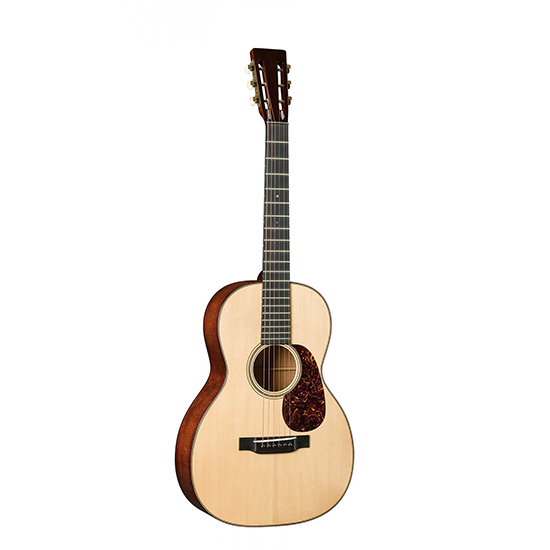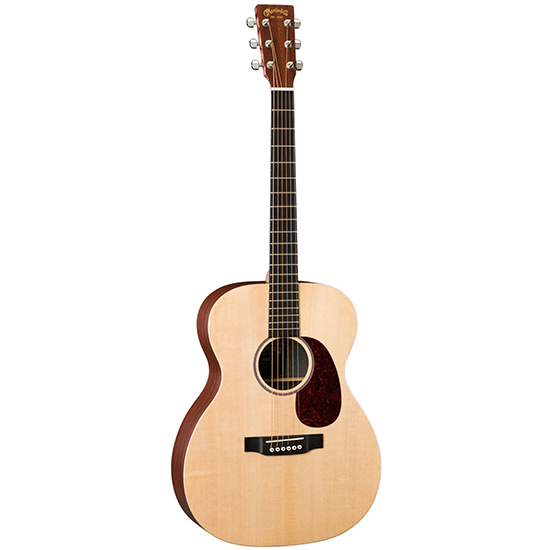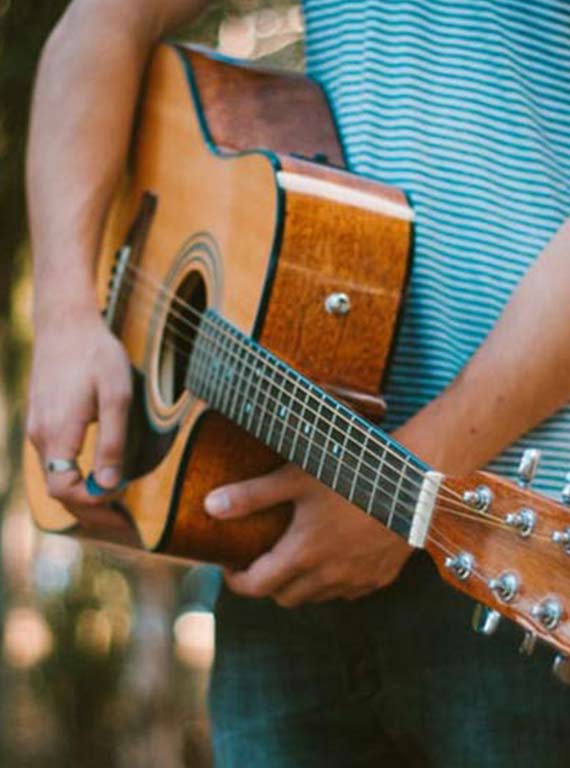WE DELVE INTO THE WORLD OF MARTIN GUITARS AND UNCOVER SOME OF THE LESSER-KNOWN FACTS ABOUT ONE OF THE MOST POPULAR ACOUSTIC GUITAR BRANDS IN THE WORLD
We decided to look into what makes Martin guitars so damn good! here's a few facts about Martin guitars that you (probably) don't know, and some of the reasons why these guitars are widely regarded as the holy grail of acoustics.
1. HIDE GLUE REALLY DOES MAKE A DIFFERENCE
Martin guitars used hide glue from their beginnings until the 1960s where it was swapped out for more environmentally friendly options and something that was easier to work with. However, guitarists, and Martin firmly believe that Hide glue makes a true difference to the sound. We’re inclined to agree! This use of hide glue is now often revered by luthiers and guitar aficionados alike as it creates a stronger bond between each part of the guitar. Ok, you’re probably thinking “Doesn’t all glue create a bond?” and yes, you’re totally right, but the way hide glue sets and ages over time creates a stronger, more cohesive bond between each piece of the guitar. It not only fuses to the wood but starts to become part of its ‘DNA’ if you will, effectively turning many pieces of wood into one. This adds to the resonance of the guitar and improves the sonic quality as the entire guitar is essentially one piece of wood. Hide glue creates a cohesive rather than adhesive bond and transfers the tone across the guitar a lot better. This is part of the reason Martin guitars will reverberate for a lot longer than most guitars. Hide glue is now used on the Martin Authentic series guitars and can be requested as part of the custom shop. Paying that little extra really makes a huge difference to your sound.

2. THE QUARTERSAWN METHOD IS EXTREMELY DIFFICULT BUT BRINGS OUT THE BEST SOUND
Martin use the quarter sawn technique when they cut their wood. This preserves the tonal qualities of the wood, utilises the grain effectively and applies far more stability to your guitar. It also looks a lot better too! Quarter sawn wood utilises the beauty of the grain far more than other methods. Quarter sawn wood is far less likely to expand and contract to guitar-breaking levels, too. And although you still need to look after your guitar as much as possible by placing it in it’s case when you’re finished playing, the quarter sawn technique helps keep your guitar from bowing and shrinking too much. This technique is not employed by all guitar companies due to the cost, but Martin take extra care to ensure a vast majority of their guitars are quarter sawn. Due to the strength of quarter sawn wood, Martin guitars are ideal for use with heavier string gauges. In addition, you also get distinctly brighter tone due to its density. Here’s a little video explaining the exactly what quarter sawn wood is:
3. MARTIN GUITARS USE A THINNER GLOSS FINISH ON THEIR GUITARS
Most guitars these days come with a lacquer or ‘finish’ on them. This is of course to protect the guitars from the elements, scratches, dings and basically make sure your guitar last a long time. In case you haven’t noticed, almost any Martin guitar that you see in the hands of an artist will look worn, not badly worn, but worn nonetheless. This due to the small amount of finish Martin use. The team at Martin create guitars with a thinner gloss finish on their guitars, not to make them age quicker, but to ensure that the tone of your guitar is the best that it can be. The thinner the lacquer, the better the tonal transfer If a guitar is weighed down by too much lacquer, it may sound a little dull, or tend to lose its reverberation quickly. Martin guitars use a lot less of their lacquer finish than most brands. More than enough to protect your guitar for many years, but not so much that your tone is lost. This is why a Martin guitar looks amazing and sounds better with age – it’s allowed to breathe and age the way wood should!
4. THEY RESPONSIBLY SOURCE THEIR WOOD
Martin care about the environment and source their wood responsibly. In fact, they were one of the first companies to ensure that all of their wood was CITES Certified. If you don't know what that is, we suggest reading our A Guide To The CITES Law On Rosewood Guitars! They not only make sure that each guitar they make is responsibly sourced, but they also ensure that wastage is cut down to a minimum, using “imperfect” wood to create other instruments and "alternative" woods. These offshoots or parts of wood that don’t make the cut due to breakages or slight imperfections are all turned into HPL (high-pressure laminate) or used for their Stratabond necks which are compressed pieces of wood layered on top of each other. This high-pressure laminate and Stratabond is extraordinarily strong, hardwearing and sounds amazing. You’ll find this on the likes of the Martin Ed Sheeran Divide guitars and the Martin X series.

5. WITHOUT THE CARE AND ATTENTION TO THE SOUNDHOLE, THE GUITAR WOULD SNAP IN HALF
Each of the Martin guitar luthiers have a speciality; whether it’s creating the neck, the fretboard, selecting the right wood (which is a ridiculously tough job) or creating the perfect rosette for the guitar. Any fan of martin guitars will know that the rosette around the sound hole looks stunning, ranging from contrasting woods, to elaborate motifs. The reason for this care and attention, is that the rosette actually strengthens the sound hole as well as the stability and strength of the guitar. Each rosette is carefully designed and placed within the sound hole by hand, making sure that the design is perfect and that the guitar is perfectly balanced. Quite often we’ll look at the sound hole of our guitars and think “oh that’s nice” when in actual fact, this is one of the most important things stopping the neck completely folding over on itself!
6. THE CUSTOM SHOP IS OPEN TO EVERYONE
Most artists these days play Martin acoustic guitars. It’s just a fact really. Their rich history in music, and the fact CF Martin was responsible for creating the acoustic shapes we see today such as the Dreadnought is as much a part of music as the notes we play. This is why so many artists want their own piece of history and choose to create their own model in the Martin custom shop. And you can too, as the Martin custom shop is open to everyone. So, where are martin guitars made? Almost al Martin guitars are made in the C.F. Martin facility in Nazareth, Pennsylvania, USA. The X Series (HPL) as well as the Backpacker Series, Road Series, and the SO and Martin S1 Uke which are made the Martin plant in Mexico. If you’ve ever wanted your own guitar, with each part specifically designed to your needs, all you have to do is ask. Simply speak to us at your local PMT store and we will facilitate that for you. You can choose your wood, shape, fret board, inlays, rosette design – pretty much anything! Just ask a member of our team and we can set it up for you. Getting your own one of a kind guitar is completely easily, and it will be hand made by their expert luthiers in the C.F. Martin facility in Nazareth, Pennsylvania.
7. ALTHOUGH ROBOTS ARE USED, THESE GUITARS ARE STILL HAND MADE!
Martin is a family owned business with most of the workers there clocking in well over 5-10 years of service. The fact is, people don’t like leaving and the company loves their staff. This dedication to the company shows through in the construction of the guitars. Aside from certain aspects like the channelling for the truss rod, and the removal of finish underneath the bridge area, most of the guitar is created and finished by hand. This means each guitar has a personal touch to it. The pride in the construction shows through. “You can have whatever robot you want. As long as it doesn’t replace a human.” I’m paraphrasing here, but Chris Martin, owner and head of Martin guitars was very clear that the human element to the construction of his company’s guitars was intact. This means that each guitar is a little different, and means that each guitar that comes out of the C.F. Martin facility in Nazareth, Pennsylvania has that human character to it. So when someone asks "Are Martin guitars good?" the answer is yes - they're world-class. These are just some of the reasons Martin guitars are so revered. Isn't it about time you finally got yours? Shop a full range of Martin guitars over at PMT Online today, or call into your local PMT store and try one out for yourself.




